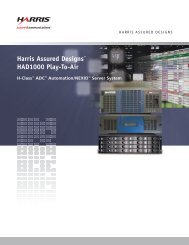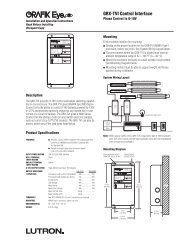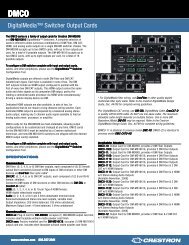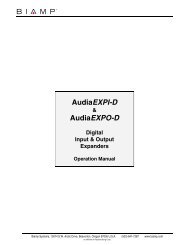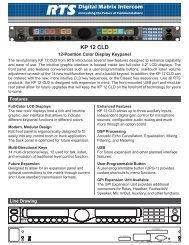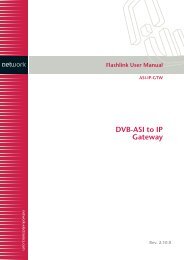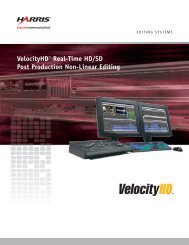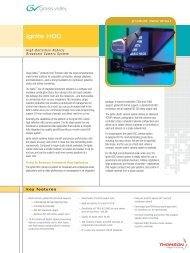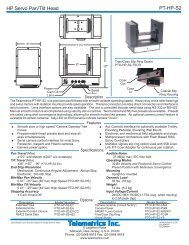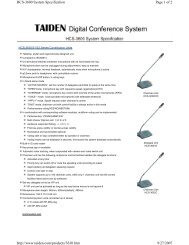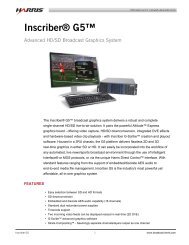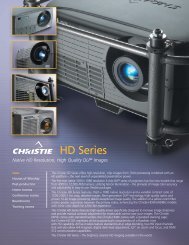Studer 928
Studer 928
Studer 928
- No tags were found...
You also want an ePaper? Increase the reach of your titles
YUMPU automatically turns print PDFs into web optimized ePapers that Google loves.
<strong>Studer</strong> <strong>928</strong><br />
Analog Mixing System
<strong>Studer</strong> <strong>928</strong><br />
Concentrated functionality<br />
Rarely does an analog mixing console offer such a concentration of<br />
functions. The <strong>Studer</strong> <strong>928</strong> provides a wealth of features and facilities<br />
at a cost effective price with no compromise<br />
on <strong>Studer</strong>s traditional quality.<br />
The 30 mm module architecture, the<br />
low-current technology (no ventilators<br />
required) and the possibility of<br />
integrating <strong>Studer</strong> modules from<br />
the existing mixing console families<br />
make this unit extremly<br />
versatile. As a consequence,<br />
the <strong>928</strong> is already used in<br />
many studios around<br />
the world as production<br />
or on-air console,<br />
in radio and TV OB<br />
vans, as a live console<br />
in sports and concert broadcasts, or for<br />
concert and theater PA applications. <br />
Up to 96 inputs<br />
Eight groups, four masters<br />
10 AUX channels<br />
Direct output, also as n-1, from each input<br />
module<br />
Four-band parametric equalizer<br />
All switches are electronic; where this is not<br />
possible only goldplated contacts are used.<br />
Quality VCAs; VCA grouping with linear faders<br />
as group masters<br />
<strong>Studer</strong> transformers on all inputs and outputs<br />
Limiter/compressor, can be assigned to any<br />
input via the insert patch panel; time constants<br />
are optimized according to psychoacoustical<br />
principles.<br />
<strong>Studer</strong> Euro boards can be installed in a 19"<br />
card chassis.<br />
Reliability<br />
For maximum reliability a redundant power<br />
supply is available which in the event of a failure<br />
in the primary supply allows uninterrupted<br />
operation. <br />
Patch panel<br />
An integrated, large-capacity patch panel for<br />
inserting external effect machines or the built-in<br />
limiter/compressor are standard features of the<br />
<strong>Studer</strong> <strong>928</strong>.
Standard Modules - functional, logically designed elements<br />
Mono Input Module<br />
The input module provides a direct<br />
output that can also be<br />
switched to n-1. Individual talkback<br />
on this output is possible<br />
with the talkback key. The mono<br />
input module feeds 8 mono group<br />
and 2 stereo master busses.<br />
The Mono Input Module features<br />
two completely separate, highquality<br />
microphone/line inputs.<br />
Signaling and monitoring can be<br />
switched between DJ or studio microphone.<br />
The microphone input<br />
is equipped with transformers.<br />
Line inputs are electronically balanced<br />
(transformer optional).<br />
A 48 V phantom supply can be<br />
switched to the mic input.<br />
The Parametric Equalizer comprises<br />
high, low and two band<br />
passes, with adjustable center/<br />
corner frequencies. The Q of the<br />
bandpass equalizer is switchable.<br />
The high-pass filter contains a<br />
phase inverter.<br />
Stereo Input Module<br />
The Stereo Input Module is equipped<br />
with electronically balanced,<br />
high-level inputs (transformer optional)<br />
for line 1 and line 2.<br />
The signal can be channel swapped<br />
via the L/R key, or switched to<br />
mono individually for each channel.<br />
By means of a rotary control the<br />
signal to the master output can be<br />
varied from mono to expanded<br />
stereo. <br />
Master module<br />
The Master Module features a<br />
limiter with adjustable threshold<br />
and release time. The attack time<br />
is selectable in two steps.<br />
The master fader of the AUX paths<br />
and the corresponding prelistening<br />
keys are also arranged on<br />
the master module.<br />
Each of the two stereo master modules<br />
is equipped with a separately<br />
controllable mono output which<br />
can be derived before or after the<br />
output fader. <br />
Monitoring, Talkback<br />
The Monitoring Module has a<br />
source selector for internal and<br />
external sources, as well as selectors<br />
for listening via headphones,<br />
monitor speakers, or near-field<br />
monitors. The cue signal can be<br />
derived either pre channel fader<br />
of the selected input module or<br />
post (solo function without influence<br />
on the mixdown).<br />
The Talkback Module consists of<br />
a test generator, talkback control<br />
and studio monitoring control.<br />
Talkback can be routed to all AUX<br />
paths, groups, as well as masters<br />
and also into the studio and to external<br />
lines. Communication to<br />
the direct (n-1) outputs of individual<br />
inputs can be preselected<br />
directly in the corresponding input<br />
modules. The volume for the<br />
studio can be adjusted individually<br />
for two headphone sets as<br />
well as for the studio speaker. Two<br />
user-assignable keys are available<br />
for signaling.<br />
6 Mono AUX outputs are fed via<br />
single potentiometers, 2 stereo<br />
AUX outputs with level and<br />
pancontrols. Each AUX path can<br />
be derived pre or post channel<br />
fader.<br />
Both units are equipped with<br />
two linear faders each which act<br />
as VCA group faders. <br />
The Pancontrol is connected directly<br />
to the stereo master output.<br />
The panselection can be enabled/<br />
disabled, also by remote control.<br />
The Main Fader is a Penny & Giles<br />
(100 mm) linear fader; it controls<br />
a high-quality VCA. Up to four<br />
VCA groups can be defined. The<br />
master faders for these groups are<br />
located in the CR and studio monitor<br />
modules. Fader start is<br />
selectable as pulse or hold function.<br />
CUE can be derived pre or<br />
post fader. A small LED bargraph<br />
will display the level before or after<br />
the equalizer or the level of the<br />
direct (n-1) output. <br />
Group module<br />
The Group Module is equipped<br />
with an additional stereo return<br />
with level and pan control and<br />
prelistening output. High-level<br />
stereo sources can be routed directly<br />
into the master channels.<br />
In each group module a limiter/<br />
compressor unit is installed. This<br />
can be inserted directly into the<br />
group or assigned to any input via<br />
the integrated insert patch panel.
The meter bridge can hold all <strong>Studer</strong> modules 170 x 40 mm. Shown as example are:<br />
VU Meter with Gain Reduction Meter 1.913.231<br />
2CH PPM Meter 30LED 1.913.105<br />
2CH VU Meter 30LED 1.913.106<br />
1CH PPM Meter 30LED 1.913.101<br />
Correlator 2CH 30LED 1.913.109<br />
Bargraph 2CH PPM 1.913.111<br />
Further possible modules are (not shown):<br />
Correlator 4CH 1.913.211<br />
PPM with Gain Reduction Meter 1.913.221<br />
Correlator 4CH 30LED 1.913.100<br />
Correlator 4CH 1.913.210<br />
PPM Meter 1.913.220<br />
VU Meter 1.913.230<br />
2CH PPM Meter 30LED<br />
with Gain Reduction Meter 1.913.107<br />
2CH VU Meter 30LED<br />
with Gain Reduction Meter 1.913.108<br />
Dual Bargraph VU 1.913.112<br />
Stereo-Display DK-Audio MSD 200 1.913.400<br />
Special Modules -<br />
expanded functionality in a consistent design<br />
Surround sound<br />
The <strong>Studer</strong> <strong>928</strong> can be equipped for multiformat film<br />
or TV surround productions. By means of a special<br />
multichannel monitor, monitoring can be set to any<br />
format between mono and 6-channel mode, and<br />
controlled direct, encoded or decoded. In this way<br />
quality monitoring is possible also including the<br />
codec processing. The individual speakers can be<br />
switched on/off, including near-field monitors.<br />
Multiformat mixdown is eased by the use of joysticks<br />
(optional). <br />
Monitor Mixer for multichannel recording<br />
The optional monitor mixer is available in a 2-channel<br />
or a multiformat surround version. The level control<br />
pots are combined with a panpot function. 8, 12, 24<br />
or 48 channel recorders can be connected and mixed<br />
down on stereo or multiformat surround.<br />
The AUX channels are expanded by two mono and<br />
one stereo channel for additional headphone feed<br />
or effect unit insertion.
Block Diagram
Technical Data<br />
Dimensions<br />
General Measuring Conditions<br />
0 dBu = 0.775 V.<br />
All linear faders are set to the 0 dB position.<br />
Line outputs are terminated with 600 Ohms.<br />
Sources have source impedance of less than 200 Ohms.<br />
All data are valid in the frequency band between 31.5 Hz and 16 kHz.<br />
The nominal line output level is (Sinus, 1 kHz): in the PPM version: 100% = +6 dBu<br />
in the VU-Meter version:<br />
0 VU = +4 dBu<br />
Levels<br />
Microphone input sensitivity:<br />
Line input sensitivity:<br />
In/output at insert points:<br />
At Direct (n-1) output:<br />
Output level:<br />
Monitor output level (unloaded):<br />
Overload margin<br />
Microphone input: Max level for 1% 3rd harmonic distortion @ 31.5 Hz:<br />
Line input: Max level for 1% 2nd harmonic distortion @ 31.5 Hz:<br />
Before channel fader (T.H.D. = 1%):<br />
Before master fader (T.H.D. = 1%):<br />
Max. Output level with transformer:<br />
without transformer:<br />
-71 ... +10 dBu<br />
+6 dBu ±14 dB<br />
+6 dBu<br />
+6 dBu<br />
+6 dBu ±10 dB<br />
+6 ... +15 dBu<br />
+13 dBu<br />
+24 dBu<br />
+20 dBu<br />
+20 dBu<br />
+23.5 dBu<br />
+23 dBu<br />
Impedances<br />
Microphone input (transformer):<br />
> 1.6 kOhms<br />
Line input (electronically balanced, transformer optional):<br />
> 10 kOhms<br />
Line output (all electronically balanced, master outputs with optional transfomer): < 40 Ohms<br />
Common mode rejection<br />
Microphone input (U in = 0 dBu, v = 0 dB, fine adjust = min) @ 15 kHz:<br />
@ 50 Hz:<br />
Line input (50 Hz ... 15 kHz): with transformer:<br />
electronically balanced:<br />
> 50 dB<br />
> 75 dB<br />
> 50 dB<br />
> 46 dB<br />
Frequncy response<br />
with EQ switched off:<br />
± 0.5 dB<br />
3 dB points approx.: 4.5 Hz, 40 kHz<br />
Bass cut (18 dB/Oct.):<br />
3 dB @ 75 Hz<br />
High frequency equalizer<br />
1 ... 16 kHz: ±15 dB<br />
High/mid equalizer<br />
500 ... 8k Hz: ±15 dB<br />
Low/mid equalizer<br />
125 ... 2k Hz: ±15 dB<br />
Low frequency equalizer<br />
32 ... 500 Hz: ±15 dB<br />
Unweighted noise (acc. to IEC 468-2, DIN 45405)<br />
Equivalent microphone input noise, 200 Ohm source for 23 kHz bandwith: -126 dBu<br />
S/N ratio at output, referred to line level (+6 dBu PPM-Version, +6 VU peak VU-version)<br />
on master output, master fader closed:<br />
> 95 dB<br />
one channel, all faders at 0 dB, unity gain EQ off:<br />
> 93 dB<br />
EQ on, linear:<br />
> 91 dB<br />
11 channels, all faders at 0 dB, unity gain EQ off: > 85 dB<br />
EQ on, linear:<br />
> 83 dB<br />
T.H.D. ratio<br />
T.H.D. ratio at output, referred to line level<br />
(+6 dBu PPM-Version, +6 VU peak VU-version) all faders at 0 dB, unity gain: > 70 dB<br />
Remote Power Supply<br />
Crosstalk attenuation<br />
Channel to channel without panpot:<br />
with panpot:<br />
Channel bus selector switched off:<br />
Fader attenuation, input:<br />
Fader attenuation, output:<br />
> 80 dB<br />
> 70 dB<br />
> 90 dB<br />
> 100 dB<br />
> 90 dB<br />
Power supply<br />
Mains voltage range:<br />
100 ... 240 V, 50/60 Hz<br />
Power consumption (32/8/4 console)<br />
375 VA<br />
(±15 V 9 A<br />
5 V 3 A<br />
48 V phantom supply 0.5 A)<br />
Weight of power supply unit<br />
5.1 kg<br />
Rear Connector Panel<br />
The picture shows an example of the clear layout<br />
of the rear connector panel. Top: Signalling,<br />
Talkback, Inserts and Remote Control; Middle:<br />
Audio; Multipin connectors: Studio, Monitor and<br />
AUX outputs.<br />
The data described refer to a typical console configuration. In special cases, they may differ. We reserve the right to make<br />
changes as technological progress may warrant without prior notice.
<strong>Studer</strong> Professional Audio GmbH, Althardstrasse 30, CH-8105 Regensdorf-Zurich Switzerland, Tel. +41 1 870 75 11, Fax: +41 1 840 47 37<br />
http://www.studer.ch<br />
Subject to change. <strong>Studer</strong> is a registered trade mark of <strong>Studer</strong> Professional Audio GmbH<br />
Printed in Switzerland 10.26.3840 (Ed.0999). Copyright by <strong>Studer</strong> Professional Audio GmbH





